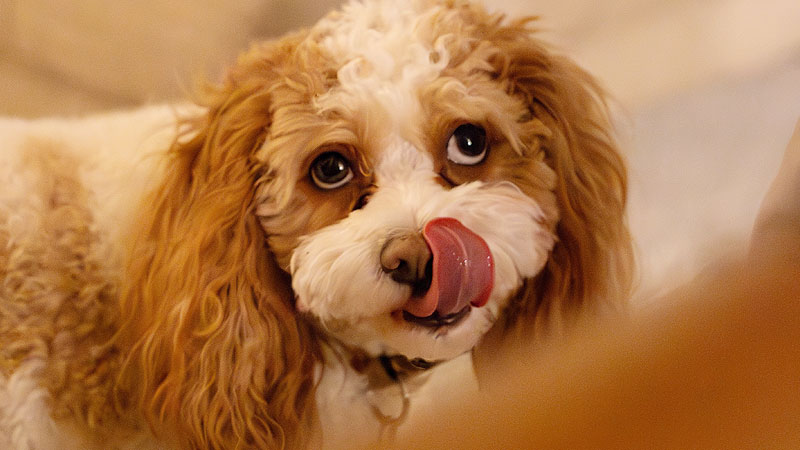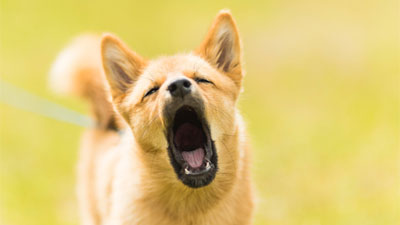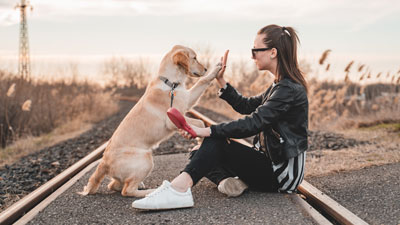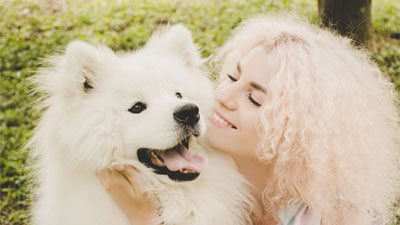- Size
- Smallest
- Small
- Small to Medium
- Medium
- Large
- Giant
- Characteristics
- Smartest
- Hypoallergenic
- Fluffy
- Best Guard
- Best Family
- Best for Kids
- Low Shedding
- Healthiest
- Police Dogs
- Most Calm
- Quietest
- Color
- White
- Black
- Grey
- Brown
- Blue
- Red
- Coat
- Hairless
- Short
- Long
- Origin
- Japan
- China
- Australia
- Germany
- Italy
- United States
- France
- Group
- Hound
- Terrier
- Herding
- Toy
- Working
- Sporting
What Does It Mean When a Dog Licks Its Lips?

Photo by Jude Wilson on Unsplash
Dogs communicate in a multitude of ways, using their body language and vocalizations to convey their thoughts and emotions. One of the common behaviors that dogs exhibit is lip licking, but have you ever wondered what it means when a dog licks its lips? In this article, we will delve into the world of canine communication and explore the various reasons behind this seemingly simple yet significant action. So, grab a treat for your furry friend, and let's decode the meaning behind a dog licking its lips.
Understanding Lip Licking in Dogs
Lip licking, also known as "lip-smacking," is a behavior where a dog quickly flicks its tongue and licks its lips, often in a rapid and repetitive manner. It may be a subtle and brief action or a more exaggerated movement, depending on the dog and the situation.
It's important to note that lip licking in dogs can have multiple meanings and interpretations depending on the context in which it occurs. To understand the meaning behind a dog's lip licking, it's essential to consider the overall body language and the situation in which the behavior is exhibited.
5 Possible Reasons for Lip Licking in Dogs
1. Social Communication
Dogs are highly social animals and use various forms of body language to communicate with each other and with humans. Lip licking can be a way for dogs to signal their intentions and emotions during social interactions.
For example, if a dog licks its lips during a greeting or while being approached by another dog or person, it can be a sign of appeasement or submissiveness. This behavior indicates that the dog wants to avoid conflict and is trying to communicate a peaceful intention.
2. Stress or Anxiety
Lip licking can also be a response to stress, anxiety, or fear in dogs. When faced with a situation that makes them uncomfortable, dogs may lick their lips in an attempt to self-soothe and calm themselves down.
For instance, if a dog is in a crowded or noisy environment, they may lick their lips as a way to cope with the overwhelming stimuli. This behavior can also occur during veterinary visits, car rides, or when encountering new and unfamiliar situations.
3. Anticipation or Excitement
In some cases, dogs may lick their lips when they are excited or anticipating something positive. This behavior can be observed when a dog is eagerly awaiting a treat or a meal, or when they are getting ready for playtime or an outdoor adventure.
The lip licking in this context is often accompanied by other signs of excitement, such as a wagging tail, bouncing body, or a playful demeanor. It signifies the dog's anticipation and enthusiasm for what is to come.
4. Medical Reasons
Although less common, lip licking in dogs can sometimes be a symptom of an underlying medical issue. Certain medical conditions can cause dogs to display excessive lip licking or smacking.
For example, dogs with gastrointestinal problems, such as acid reflux or nausea, may lick their lips as a response to an upset stomach. Additionally, discomfort or pain in the mouth or throat, like dental issues or tonsillitis, can also lead to increased lip licking.
5. Learned Behavior
In some cases, lip licking can become a learned behavior that is reinforced through positive associations. For instance, if a dog licks its lips and receives attention or a reward from their owner, it may continue to perform this behavior as a way to elicit a similar response in the future.
It's important to recognize and understand your dog's unique learned behaviors to ensure that they are reinforced appropriately and not causing any distress or confusion.
Interpreting Lip Licking in Dogs
When observing a dog licking its lips, it's crucial to interpret this behavior in conjunction with other signs and body language cues. Here are a few factors to consider when deciphering the meaning behind a dog's lip-licking:
Overall Body Language: Evaluate the dog's entire body language and take note of any other signals they are displaying. Are they exhibiting signs of relaxation or tension? Are their muscles relaxed or stiff? Considering the context of the situation and the dog's overall demeanor can provide valuable insights.
Frequency and Intensity: Take note of how often and how intensely the dog is licking its lips. A single, brief lick may have a different meaning compared to a repeated, rapid licking. The intensity of the lip licking can also indicate the dog's level of discomfort or stress.
Environmental Factors: Consider the environment in which the lip licking is occurring. Is the dog in an unfamiliar or challenging situation? Are there any potential triggers or stressors present? Understanding the external factors can help provide clues about what the dog may be trying to communicate.
Personal History and Context: Every dog is an individual, and their previous experiences play a significant role in shaping their behavior. Understanding your specific dog's history and the context in which lip licking occurs for them personally can help in interpreting the behavior.
In Conclusion
Lip licking in dogs is a complex behavior that can have multiple meanings depending on the context. While it can serve as a social signal, a response to stress or anxiety, an expression of anticipation or excitement, or even a symptom of an underlying medical issue, understanding your dog's unique body language and situation is key.
By considering the overall body language, interpreting the frequency and intensity of the behavior, and taking into account the environment and context, you can gain valuable insights into what your dog may be trying to communicate. With patience, empathy, and keen observation, you can deepen your understanding of your furry companion's needs and strengthen your bond with them.
You May Also Like
 Dog BehaviorWhy Do Dogs Yawn? and The Meaning Behind
Dog BehaviorWhy Do Dogs Yawn? and The Meaning Behind Help & Advice7 Reasons Why Dogs Always Keep Their Mouths Closed
Help & Advice7 Reasons Why Dogs Always Keep Their Mouths Closed Dog BehaviorThe 6 Common Dog Sounds and Their Meanings
Dog BehaviorThe 6 Common Dog Sounds and Their Meanings Help & AdviceWhat Is The Hardest Dog Trick?
Help & AdviceWhat Is The Hardest Dog Trick? Dog Training TipsHere are the 7 Most Important Dog Commands
Dog Training TipsHere are the 7 Most Important Dog Commands Dog Training Tips5 Easy Steps: How to Teach a Dog to Smile
Dog Training Tips5 Easy Steps: How to Teach a Dog to Smile